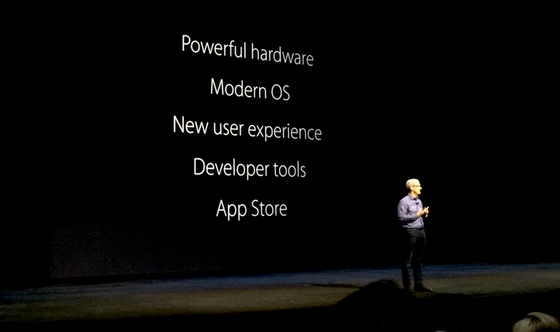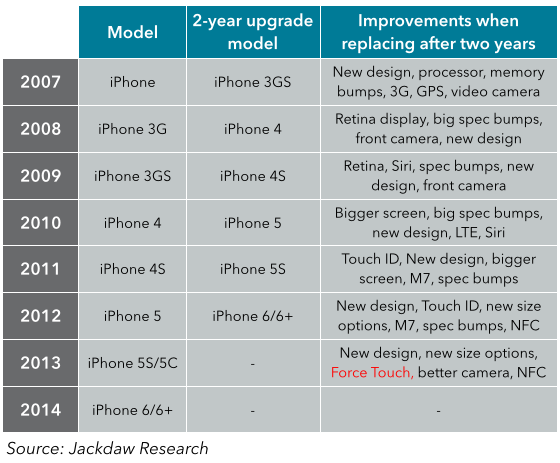There’s going to be tons of noise this week about Apple’s earnings, with a particular focus on the sales of the Apple Watch. However, there are two key problems with all of this, and they are:
- Apple almost certainly won’t give us the number of Watches sold, and estimating that number requires making a series of assumptions, which taken together make the resulting number pretty imprecise
- Whatever the number various people come up with, we’ll be deluged with articles saying that the Watch has somehow flopped, that sales have fallen short of expectations, and so on, because it’s enormously difficult to know how to evaluate the number.
The rest of this post fleshes out these two points, with a view to providing some context for tomorrow’s earnings call.
The difficulty of estimating Apple Watch sales
As a quick reminder (for a longer primer, listen to this week’s episode of the Beyond Devices podcast), Apple Watch revenues will be reported under the “Other Products” segment, one of Apple’s five product segments, as of earlier this year. And in that Other Products category, you’ll also find revenues from the iPod (until recently broken out separately), third-party accessories, Apple’s own accessories (including Beats headphones), and Apple TV. Last quarter, that was a $1.7 billion revenue bucket, which was down about 10% year on year, but the rate of growth or decline has been fairly unpredictable. So the first thing you have to do if you want to calculate Apple Watch revenues is to make a set of assumptions about the rest of this segment and what results would have looked like without the Apple Watch. Perhaps you decide that revenues would have been around $1.6 billion based on that same 10% year on year decline, though in reality the range is likely anywhere from $1.4 billion to $2 billion based on the trends from the past two years. That, by itself, gives you around 1 million units’ worth of softness in your estimate between the two extremes.
At that point, you have your Apple Watch revenue number, and you’re ready to move on to the next step, which is figuring out how that revenue number translates to unit shipments. The challenge here, of course, is that this is easily the widest price spread of any Apple product: from $349 all the way up to $17,000 (and that’s just the US dollar pricing). The assumptions you make about the mix between the various models are going to make a huge difference to the unit shipment number you come up with. In the grand scheme of things, Edition sales are likely to be tiny, but at that price point (around 20 times that of the midpoint of the other models), small differences in your assumptions will make big differences in your outputs. For the sake of illustration, I’ve presented in the table below three possible scenarios, which all give roughly the same total revenue figure of around $4 billion for the quarter:
 However, what you’ll see is that, depending on how you flex the mix between the three models, you’ll get a very different number of shipments – under these three scenarios, anything from 3.15 million to 7.8 million. And one of the biggest variables is the number of Edition sales you assume, as you can see from the third column. However, as the third scenario shows, if you shift the mix between the other two models radically, you get a similarly significant effect. So much depends on your assumptions. For what it’s worth, none of the three scenarios above represents the mix I’m expecting to see – they’re purely illustrative. I would think we might see around 5 million sales, at around $3-4 billion in revenue, but along with everyone else, I’m guessing now, and I’ll be guessing to an only slightly smaller extent after the results are out.
However, what you’ll see is that, depending on how you flex the mix between the three models, you’ll get a very different number of shipments – under these three scenarios, anything from 3.15 million to 7.8 million. And one of the biggest variables is the number of Edition sales you assume, as you can see from the third column. However, as the third scenario shows, if you shift the mix between the other two models radically, you get a similarly significant effect. So much depends on your assumptions. For what it’s worth, none of the three scenarios above represents the mix I’m expecting to see – they’re purely illustrative. I would think we might see around 5 million sales, at around $3-4 billion in revenue, but along with everyone else, I’m guessing now, and I’ll be guessing to an only slightly smaller extent after the results are out.
(Note: an early version of this post had an error in the spreadsheet above, which has now been corrected – the core point remains unchanged).
What constitutes success?
Now that we’ve established the pitfalls associated with estimating actual numbers, we move on to the other big question: how we should evaluate those numbers. This also goes to the heart of the question of why Apple likely won’t give us any numbers, which comes down to two things:
- Early in a product cycle, the actual numbers are as much a function of supply as of demand, and so they don’t reflect actual demand accurately
- Apple has barely started to sell the Watch, there are significant updates coming later in the year, and the word-of-mouth marketing which I still expect to be a big component of how sales grow has barely got off the ground, because there simply aren’t that many Watches out there.
You could make a strong argument that, whatever the actual numbers are, the Watch launch has already been a huge success, for two reasons: firstly, demand continues to outstrip supply, which (assuming supply isn’t being artificially constrained to create the illusion of shortages) is always a good sign; secondly, Apple is now catching up to demand across 18 SKUs and many variants behind those, which is logistically an enormous achievement by itself. With previous major product launches, there was essentially one SKU – one iPod, one iPhone – or slight variations by storage capacity. One of the biggest challenges from a supply chain and logistics perspective for the Watch has been the sheer variety of the individual models and the difficulty of predicting which would be most popular.
Another way to look at sales is in the context of past Apple product launches and there, too, the Apple Watch likely comes out ahead. The iPod sold 125,000 in its first quarter, the iPhone sold 270,000, and the iPad sold 3.3 million. Watch sales might be close to the iPad launch, but I suspect they’ll be higher. However, unlike the iPad, which was a standalone device from the beginning, the Watch is a companion device to the iPhone, so its addressable market is arguably narrower. Compare Apple Watch sales to the sales of any other smart watch or even fitness device, though, and they again come out on top. Fitbit sold 3.9 million devices of all kinds in Q1, so Apple Watch might again be close to that this quarter, but probably slightly above it, and Fitbit is by far the market leader in this category, with smartwatches a much smaller category (and a small subset of Fitbit’s device sales).
What next?
Is there any sense in which the Apple Watch can be considered not to have been a success, assuming the numbers come in roughly where I think they will? I think so, but it’s mostly a matter of timing. What I mean by that is that I suspect the Apple Watch will quickly get to the point where it’s Apple’s second-highest selling product, behind the iPhone but ahead of the iPad, probably either in Q4 this year or sometime next year. But for now, it’s quite a bit smaller than Apple’s other products. It doesn’t seem to be hitting the same mainstream consciousness as other recent Apple devices as quickly.
I regularly meet people for whom my Apple Watch is the first one they’ve seen in the wild, as it were. And I continue to believe that word of mouth marketing is the most effective form of marketing for the Apple Watch, as a new product in the market, and as a product that’s distinct even from other entrants in the category. My wife and I both have Watches, and when people spot them, they often ask, “How is it?” or “Do you like it?” And we both respond, “It’s great” or words to that effect, but I continue to struggle to articulate the reason why they’d be great for everyone, or even for most people. My Watch is enormously useful to me because of the notifications especially, though I also enjoy the at-a-glance information on the screen at all times, and the fitness tracking is a nice bonus.
I suspect that what will really start to change this is the emergence of a really strong set of third party apps, and that will have to wait for WatchOS 2 in a few months’ time. Apps were critical to the success of the iPhone and iPad, and I think they’ll be even more critical to the success of the Watch, and I’ve said this from the start. It’s only when you get innovation happening among third party developers about what’s really possible when you have a wrist-worn, always-present supercomputer that you’ll really start to see the potential in this category. And allowing those developers to run their apps on the Watch itself, and to make use of both the hardware and software features that Apple’s own apps already have access to will be a huge step forward.
As such, I’m expecting that Q3 may be a quieter quarter for the Watch, in which Apple may well sell fewer devices than in Q2, but Q4 will be absolutely huge, both because of the impact of WatchOS and native apps, but also because of holiday buying, at a time when many more people will know someone who has a Watch and loves it.
 What I found striking about this slide was that it was a great summation of Apple’s playbook for its tightly integrated approach to hardware and software:
What I found striking about this slide was that it was a great summation of Apple’s playbook for its tightly integrated approach to hardware and software:

